Herbs have been used to dye yarns and garments for thousands of years. The colors are not as vibrant or durable as the chemical dyes currently used. These days, people are trying to get away from using chemicals, turning to safer, natural alternatives.
To get the best colors from your herbs, harvest the flowers as you would dried flowers, before they are fully open. Leaves should be harvested in the spring and roots in the fall.
The mordants used to set the colors, also influence the colors themselves. Different mordants used on the same herbs will produce different colors. Even different parts of the plants will produce different colors!
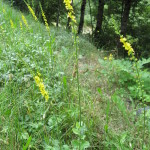 Agrimony (Agrimonia eupatoria) is a perennial hardy through zone 5. It is native to the British Isles, but has spread throughout the temperate zones of Europe and North America. Its native habitats are woodlands and fields so will grow in sun or partial shade in your garden. The plants grow up to 3 feet tall. They have yellow flowers that grow along a tall stem and appear from June through August. The seed pods have burrs on them to catch on the fur of passing animals. Agrimony is easily grown from seed and once established will happily reseed itself in your garden. Plants can be divided in the spring or the fall.
Agrimony (Agrimonia eupatoria) is a perennial hardy through zone 5. It is native to the British Isles, but has spread throughout the temperate zones of Europe and North America. Its native habitats are woodlands and fields so will grow in sun or partial shade in your garden. The plants grow up to 3 feet tall. They have yellow flowers that grow along a tall stem and appear from June through August. The seed pods have burrs on them to catch on the fur of passing animals. Agrimony is easily grown from seed and once established will happily reseed itself in your garden. Plants can be divided in the spring or the fall.
Dye parts: Use fresh leaves and stems.
Mordant: Alum produces a brassy yellow
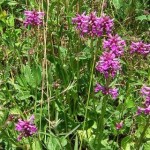 Betony (Stachys officinalis) is native to Europe, western Asia and northern Africa. It is an herbaceous perennial hardy through zone 4. It grows in full sun or partial shade. The leaves form a rosette at the base of the plant with flower stalks that can reach 3 feet. The flowers themselves range in color from white to purple. Bloomtime is late July through August. The plants should be divided every 3 years or every 5 years if growing in shady conditions. Betony is easily grown from seed.
Betony (Stachys officinalis) is native to Europe, western Asia and northern Africa. It is an herbaceous perennial hardy through zone 4. It grows in full sun or partial shade. The leaves form a rosette at the base of the plant with flower stalks that can reach 3 feet. The flowers themselves range in color from white to purple. Bloomtime is late July through August. The plants should be divided every 3 years or every 5 years if growing in shady conditions. Betony is easily grown from seed.
Dye parts: All parts of the plants are used fresh
Mordant: Alum produces chartreuse
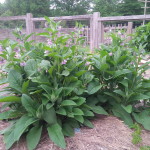
Comfrey (Symphytum officinale) is an extremely hardy perennial through zone 3. The plants are very large, easily reaching 5 feet in height and up to 4 feet in width with leaves 12 to 18 inches in length. It has a long tap root, up to 6 feet long, making it drought tolerant. Comfrey requires little care other than full sun. Although related to borage and producing a lot of seeds like borage, the seeds are sterile so you won’t have comfrey plants all over your garden. The plants grow rapidly and should be divided every 3 to 4 years.
Dye parts: Use fresh leaves
Mordant: Iron produces brown
 Fennel (Foeniculum vulgare) is a short-lived perennial native to the Mediterranean area which has naturalized around the world. Because it freely reseeds itself, it is considered an invasive weed in the US and Australia. It is hardy in zones 4 through 9. Plants can grow to a height of 6 feet. They need full sun and well-drained soil. Its long tap root makes it drought tolerant. Fennel is easily grown from seed.
Fennel (Foeniculum vulgare) is a short-lived perennial native to the Mediterranean area which has naturalized around the world. Because it freely reseeds itself, it is considered an invasive weed in the US and Australia. It is hardy in zones 4 through 9. Plants can grow to a height of 6 feet. They need full sun and well-drained soil. Its long tap root makes it drought tolerant. Fennel is easily grown from seed.
Dye parts: Use the flowers and leaves fresh
Mordant: Alum produces a mustard yellow, Chrome produces a golden brown
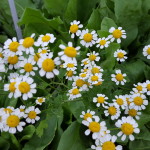 Feverfew (Tanacetum parthenium) is a perennial that is native to the Eurasian part of the Mediterranean. It spread throughout the entire Mediterranean area as well as Europe. Then European colonists introduced it to North America where it is hardy through zone 5. Mature plants reach a height of 18 to 24 inches and flower all summer provided you deadhead them regularly. Be warned that feverfew will aggressively reseed itself throughout your garden if you don’t deadhead it. It can be propagated by seed or cuttings.
Feverfew (Tanacetum parthenium) is a perennial that is native to the Eurasian part of the Mediterranean. It spread throughout the entire Mediterranean area as well as Europe. Then European colonists introduced it to North America where it is hardy through zone 5. Mature plants reach a height of 18 to 24 inches and flower all summer provided you deadhead them regularly. Be warned that feverfew will aggressively reseed itself throughout your garden if you don’t deadhead it. It can be propagated by seed or cuttings.
Dye parts: Use the leaves and stems fresh
Mordant: Chrome produces a greenish yellow
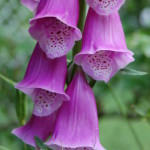
Foxglove (Digitalis purpurea) is a native to the woodland edges of Europe and North Africa. They can grow in full sun but prefer semi-shade or shade. The plants prefer rich, well-drained soil. Foxglove are biennials that are hardy in zones 4 through 8. The first year, a rosette of leaves develops at the base of the plant. The second year, the rosette of leaves grows again and then a stalk with bell shaped flowers appears in late spring or early summer. Depending on the variety, the stalks can be 2 to 5 feet high. The flowers range in color from white through pink to purple. Very often they sport spots on the insides. The flowers open from the bottom of the stalks to the top. Foxglove is easy to grow from seed.
Dye parts: Use fresh flowers
Mordant: Alum produces chartreuse
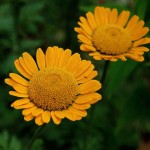 Golden Marguerite (Cota tinctoria), also known as dyer’s chamomile, is a short lived perennial that is native to the Mediterranean area and western Asia. It has become naturalized in parts of North America. It is hardy in zones 3 through 7. Golden Marguerite requires full sun and well drained soil. Plants grow 2 to 3 feet tall with yellow flowers from early to late summer. They readily reseed themselves throughout your garden. It can also be propagated through cuttings and divisions. Plants should be divided every 2 to 3 years.
Golden Marguerite (Cota tinctoria), also known as dyer’s chamomile, is a short lived perennial that is native to the Mediterranean area and western Asia. It has become naturalized in parts of North America. It is hardy in zones 3 through 7. Golden Marguerite requires full sun and well drained soil. Plants grow 2 to 3 feet tall with yellow flowers from early to late summer. They readily reseed themselves throughout your garden. It can also be propagated through cuttings and divisions. Plants should be divided every 2 to 3 years.
Dye parts: Use fresh or dried flowers
Mordant: Alum produces yellow buff, Chrome produces golden orange, Tin produces yellow
 Lady’s Bedstraw (Galium verum) is a hardy perennial that is native to the temperate parts of Europe and Asia and has become naturalized in the temperate areas of North America. It is hardy in zones 4 through 8. Plants grow 1 to 2 feet tall in full sun or part shade. The yellow flowers appear July through September. Lady’s Bedstraw is invasive and care should be taken when growing this in your garden.
Lady’s Bedstraw (Galium verum) is a hardy perennial that is native to the temperate parts of Europe and Asia and has become naturalized in the temperate areas of North America. It is hardy in zones 4 through 8. Plants grow 1 to 2 feet tall in full sun or part shade. The yellow flowers appear July through September. Lady’s Bedstraw is invasive and care should be taken when growing this in your garden.
Dye parts: Use roots fresh or dried
Mordant: Alum produces coral, Chrome produces brick red
Dye parts: Use the tops of the plants fresh
Mordant: Alum produces dull yellow
 Lavender Cotton (Santolina chamaecyparissus) is a tender perennial that is only hardy through zone 6. It is native to the Mediterranean area. It grows in silvery mounds 2 feet tall with pretty yellow button flowers that appear in June and July. It needs full sun and is drought tolerant. Lavender cotton can be propagated by seeds, cuttings, layering or division.
Lavender Cotton (Santolina chamaecyparissus) is a tender perennial that is only hardy through zone 6. It is native to the Mediterranean area. It grows in silvery mounds 2 feet tall with pretty yellow button flowers that appear in June and July. It needs full sun and is drought tolerant. Lavender cotton can be propagated by seeds, cuttings, layering or division.
Dye parts: Use fresh leaves or flowers
Mordant: Alum produces yellow, Chrome produces gold
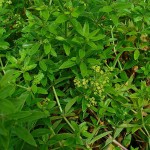 Madder (Rubia tinctorum) was originally found in the Mediterranean area and Western Asia, but has naturalized throughout Europe and North America. It is a perennial that is hardy through zone 5. The plants, which require full sun, reach 3 feet in height with stems that have short “hooks”on them to climb. If there is nothing for them to climb, the plants will lay on the ground. They bear tiny yellow flowers in early summer. The roots reach maturity and are harvestable in 2 years although most dyers wait until the roots are 3 years old to harvest.
Madder (Rubia tinctorum) was originally found in the Mediterranean area and Western Asia, but has naturalized throughout Europe and North America. It is a perennial that is hardy through zone 5. The plants, which require full sun, reach 3 feet in height with stems that have short “hooks”on them to climb. If there is nothing for them to climb, the plants will lay on the ground. They bear tiny yellow flowers in early summer. The roots reach maturity and are harvestable in 2 years although most dyers wait until the roots are 3 years old to harvest.
Dye parts: Use fresh or dried roots
Mordant: Alum produces a lacquer red, Chrome produces a garnet red, Iron produces brown, Tin produces Orange
 Sweet Marjoram (Origanum majorana) is native to Cyprus and southern Turkey. It is a tender perennial hardy only through zone 7. North of zone 7, it is usually grown as an annual or it can be brought indoors provided it has enough light. Supplemental lighting is recommended. Mature plants reach a height of 1 to 2 feet. Marjoram is happiest in full sun and dry soil. It can be grown from seed but you must be patient. The seeds are slow to germinate.
Sweet Marjoram (Origanum majorana) is native to Cyprus and southern Turkey. It is a tender perennial hardy only through zone 7. North of zone 7, it is usually grown as an annual or it can be brought indoors provided it has enough light. Supplemental lighting is recommended. Mature plants reach a height of 1 to 2 feet. Marjoram is happiest in full sun and dry soil. It can be grown from seed but you must be patient. The seeds are slow to germinate.
Dye parts: Use the entire top of the plant, fresh
Mordant: Alum produces green, Chrome produces olive green
 Roman Chamomile (Chamaemelum nobile) is a low growing perennial that is hardy through zone 4. It is native to Europe, but is now also found in North America. The plants only grow 3 to 4 inches tall with 8 to 12 inch flower stems. The flowers resemble German chamomile and have the same apple fragrance and flavor in tea. Bloom time is July and august. Roman chamomile is most often used as a ground cover or substitute for grass lawns. It grows in full sun or partial shade. It is easily grown from seed and willingly reseeds itself into your garden or lawn.
Roman Chamomile (Chamaemelum nobile) is a low growing perennial that is hardy through zone 4. It is native to Europe, but is now also found in North America. The plants only grow 3 to 4 inches tall with 8 to 12 inch flower stems. The flowers resemble German chamomile and have the same apple fragrance and flavor in tea. Bloom time is July and august. Roman chamomile is most often used as a ground cover or substitute for grass lawns. It grows in full sun or partial shade. It is easily grown from seed and willingly reseeds itself into your garden or lawn.
Dye parts: Use fresh flowers
Mordant: Alum produces bright yellow, Chrome produces yellow
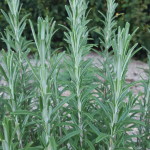 Rosemary (Rosmarinus officinalis) is native to the Mediterranean area. It is a woody perennial that is reliably hardy through zone 7. It can survive mild winters with protection in zone 6. In northern areas, rosemary should be grown in pots and brought inside once the outdoor temperatures are less than 30°F. Mature plants grown outside can reach a height of 5 feet. Rosemary requires full sun. It is also drought tolerant. Pale blue flowers appear in early spring. It is often used as an ornamental shrub because it can be pruned into hedges and topiary. Rosemary is usually propagated by cuttings.
Rosemary (Rosmarinus officinalis) is native to the Mediterranean area. It is a woody perennial that is reliably hardy through zone 7. It can survive mild winters with protection in zone 6. In northern areas, rosemary should be grown in pots and brought inside once the outdoor temperatures are less than 30°F. Mature plants grown outside can reach a height of 5 feet. Rosemary requires full sun. It is also drought tolerant. Pale blue flowers appear in early spring. It is often used as an ornamental shrub because it can be pruned into hedges and topiary. Rosemary is usually propagated by cuttings.
Dye parts: Use fresh leaves and flowers
Mordant: Alum produces yellow green
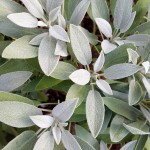 Sage (Salvia officinalis) is native to the Mediterranean but has naturalized throughout much of the world. It is a perennial sub-shrub that is hardy through zone 5. The plants become woody within three to four years and will need to be replaced. Mature plants reach a height of 3 feet in full sun or partial shade. They are drought tolerant. Sage has typical salvia type flowers usually in blue, but they can range in color from white to pink to lavender. Bloom time is late spring to early summer. Sage can be grown from seeds or cuttings.
Sage (Salvia officinalis) is native to the Mediterranean but has naturalized throughout much of the world. It is a perennial sub-shrub that is hardy through zone 5. The plants become woody within three to four years and will need to be replaced. Mature plants reach a height of 3 feet in full sun or partial shade. They are drought tolerant. Sage has typical salvia type flowers usually in blue, but they can range in color from white to pink to lavender. Bloom time is late spring to early summer. Sage can be grown from seeds or cuttings.
Dye parts: Use the entire top of the plants fresh
Mordant: Alum produces a yellow buff, Chrome produces a deep yellow, Iron produces a green gray
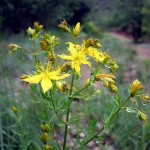 St-John’s-Wort (Hypericum perforatum) is a perennial native to Europe and Asia but has spread to Africa and North America. It is hardy through zone 5. Mature plants reach a height of 1 to 1 ½ feet. They will grow in full sun or partial shade. The plants are drought tolerant. They develop bright yellow flowers July through August. St.-John’s-Wort is easily grown from seed. It readily reseeds itself and can become invasive.
St-John’s-Wort (Hypericum perforatum) is a perennial native to Europe and Asia but has spread to Africa and North America. It is hardy through zone 5. Mature plants reach a height of 1 to 1 ½ feet. They will grow in full sun or partial shade. The plants are drought tolerant. They develop bright yellow flowers July through August. St.-John’s-Wort is easily grown from seed. It readily reseeds itself and can become invasive.
Dye parts: Use the tops of the plants fresh
Mordant: Alum produces medium yellow, Chrome produces bright yellow
Dye parts: Use fresh flowers
Mordant: Tin produces orange-red
Dye parts: Use fresh stems
Mordant: Alum produces brown-red
 Stinging Nettle (Urtica dioica) is native to Europe, Asia, northern Africa, and western North America. The plants are hardy through zone 3. They are commonly found in moist meadows and along the edges of streams in full sun or partial shade. The stems and leaves are covered with stiff hairs that “sting” when touched and should be handled while wearing gloves because they can cause an itchy rash in some people. The flowers are tiny and green. Bloom time is July through September. Stinging nettle can be easily grown from seeds or by division.
Stinging Nettle (Urtica dioica) is native to Europe, Asia, northern Africa, and western North America. The plants are hardy through zone 3. They are commonly found in moist meadows and along the edges of streams in full sun or partial shade. The stems and leaves are covered with stiff hairs that “sting” when touched and should be handled while wearing gloves because they can cause an itchy rash in some people. The flowers are tiny and green. Bloom time is July through September. Stinging nettle can be easily grown from seeds or by division.
Dye parts: All parts of the plants are used fresh
Mordant: Alum produces greenish yellow, Chrome produces tan
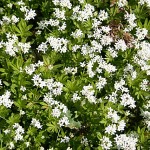
Sweet Woodruff (Galium odoratum) is a perennial hardy through zone 4. It is native to Europe and Asia and has naturalized in North America. It is most often used as a ground cover because the plants grow only 6 to 12 inches high. Sweet woodruff only grows in the shade. It has small white flowers that appear in May and June. Most gardeners buy plants because the seed is difficult to germinate, sometimes taking up to 200 days.
Dye parts: Use the leaves and stems fresh
Mordant: Alum produces tan
Dye parts: Use fresh roots
Mordant: Alum produces red
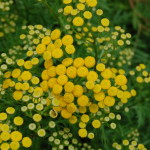
Tansy (Tanacetum vulgare) is native to temperate Europe and Asia. It is hardy through zone 4. Plants reach a height of 2 to 4 feet. Once established, they spread via underground runners as well by reseeding themselves in your garden. Tansy prefers a sunny spot, but can tolerate some shade. It requires very little care and will grow in most garden soils. It is drought tolerant and disease resistant. The plants bear small yellow button like flowers, July through September. It is easily grown from seed.
Dye parts: Use fresh, young leaves
Mordant: Alum produces yellowish green
Dye parts: Use fresh flowers
Mordant: Alum produces greenish yellow
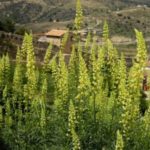 Weld (Reseda luteola) is one of the oldest dye plants used by humankind. It is a biennial that is native to Eurasia, but has become naturalized throughout Europe and North America. The first year, the plants produce a rosette of leaves that can be 12 inches across. The second year, they send up a flower stalk that grows 3 to 5 feet in height. Weld should be grown in full sun and well-drained soil. It is easy to grow from seed.
Weld (Reseda luteola) is one of the oldest dye plants used by humankind. It is a biennial that is native to Eurasia, but has become naturalized throughout Europe and North America. The first year, the plants produce a rosette of leaves that can be 12 inches across. The second year, they send up a flower stalk that grows 3 to 5 feet in height. Weld should be grown in full sun and well-drained soil. It is easy to grow from seed.
Dye parts: Use the leaves either fresh or dried
Mordant: Alum produces lemon yellow, copper produces greenish yellow, olive produces olive green
No Mordant: mix with woad to produce Lincoln Green
 Woad (Isatis tinctoria) is a biennial that is hardy through zone 4. It is native to central Asia. It has become naturalized throughout the rest of Europe and North America. The first year, the plants produce a rosette of leaves at the base of the plants. In the second year, a 4 foot stalk of yellow flowers appears. Woad prefers full sun but will tolerate some shade. It is easy to grow from seed.
Woad (Isatis tinctoria) is a biennial that is hardy through zone 4. It is native to central Asia. It has become naturalized throughout the rest of Europe and North America. The first year, the plants produce a rosette of leaves at the base of the plants. In the second year, a 4 foot stalk of yellow flowers appears. Woad prefers full sun but will tolerate some shade. It is easy to grow from seed.
Dye parts: Use fresh young leaves
Mordant: Alum produces pink, Use no mordant for blue
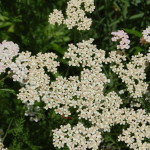 Yarrow (Achillea millefolium) is native to the temperate regions of the northern hemisphere. It is hardy through zone 3. Depending on the variety, it grows from 2 to 4 feet tall with flowers that come in red, pink, yellow and white. Again, depending on the variety, it will bloom some time between June and September. If you deadhead it, the plants will send up a second flush of flowers. Plant your yarrow is full sun and well-drained soil. Plants are drought tolerant. Yarrow is easy to grow from seed. Divide your plants every 2 to 3 years.
Yarrow (Achillea millefolium) is native to the temperate regions of the northern hemisphere. It is hardy through zone 3. Depending on the variety, it grows from 2 to 4 feet tall with flowers that come in red, pink, yellow and white. Again, depending on the variety, it will bloom some time between June and September. If you deadhead it, the plants will send up a second flush of flowers. Plant your yarrow is full sun and well-drained soil. Plants are drought tolerant. Yarrow is easy to grow from seed. Divide your plants every 2 to 3 years.
Dye parts: Use fresh flowers
Mordant: Alum produces yellow
Dye parts: Use the entire plant fresh
Mordant: Iron produces olive green

